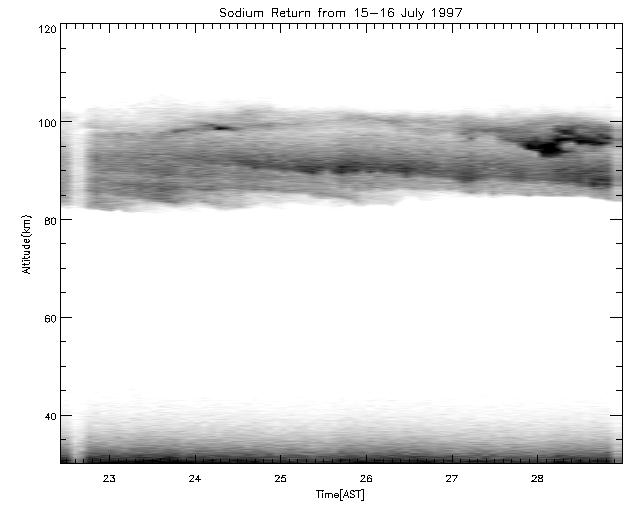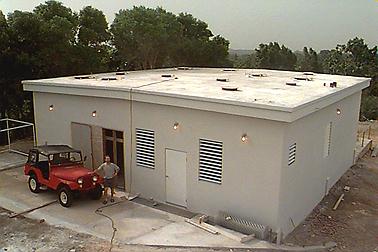
Figure 1. Doppler-Rayleigh Lidar wind data from 6-7 May, 1997
NAIC/AO Newsletter, July 1997

Figure 1. Doppler-Rayleigh Lidar wind data from 6-7 May, 1997
Beginning in February, Jonathan Friedman made neutral wind measurements with the Doppler-Rayleigh lidar, employing the new vapor filter edge technique. Results of experiments carried out in February, April and May were presented at the Spring AGU meeting in Baltimore and, submitted to Optics Letters by Jonathan.There is still much work to be done in order to properly calibrate the instrument and to extend its range.
Regular dark-moon airglow observations took place in February, March, April, June and July. These were carried out by Raúl García. Standard 630 nm Fabry-Perot and photometer, 557.7 nm photometer, and OH and O2 spectrometer measurements were made. April and June dates correspond to incoherent scatter coordinated observation periods.
During the predawn hours of April 16, the 630 nm photometer and the Cornell all-sky imager were trained on the sky during initial tests of one half of the HF transmitter. Hoped for enhancements in the 630 nm emission were not seen, but these measurements were invaluable in the initial shakedown of the upgraded, and now dry, HF in preparation for heating campaigns which begin this summer.
Sixto González attended a special workshop on ionospheric storms at MIT in March and presented measurements made from Arecibo during several storm periods. Often the ionosphere over Arecibo displays a significant and nearly instantaneous response to the onset of magnetic disturbances, even at these low latitudes. In early April, Qihou Zhou and Craig Tepley participated in the TIMED workshop held in Baltimore. TIMED is an upcoming NASA satellite mission (and an acronym for Thermosphere- Ionosphere-Mesosphere Energetics and Dynamics), which is scheduled to be launched in 2000. The original scope of the mission was reduced severely during the budget process, almost to the point of killing it. As such, ground-based instrumentation and their observations were called on to be an important part of the overall project. Ground-based measurements of the lower ionosphere, especially those made with the chain of incoherent scatter radar facilities and geographically broadly distributed lidars, are now often referred to as replacing the "fifth instrument" of TIMED. These fill in important parts of the original mission objectives that did not make it through the budget cuts.
In late April, Mike Sulzer and Brett Isham participated in this year's HF Ionospheric Interactions workshop held in Santa Fe. They discussed the upcoming series of HF Campaigns that will take place at Arecibo using the recently upgraded HF Facility. Now that the work on this facility is complete and the area is currently dry resulting from the repair of the pumps, we look forward to a return to operation of this instrument and a clearing of the backlog of observing proposals that have accumulated.
Also in late April, Chet Gardner of the University of Illinois visited Arecibo to discuss two major upcoming experiments that he and others are planning. The first in 1999 will involve several aircraft flights over Puerto Rico as well as from Quito, Ecuador. Onboard lidar and imaging instrumentation will measure the horizontal distribution of metallic layers and, in particular, sudden atom layers, while we observe similar features from the ground. The second study in 2000 is a possible effort to understand convective and turbulent features of the tropical lower atmosphere using radar and optical instruments located throughout Puerto Rico. Although northern Australia is another location being considered for the latter study, we, of course, feel that Puerto Rico can offer several superior advantages, such as a more extensive cluster of instruments that can be applied to this investigation.
Key meetings in May included the Annual Spring Meeting of the American Geophysical Union held in Baltimore, and the 9th Annual Puerto Rican EPSCoR/AAAS Meeting held in Fajardo. Sixto González and Jonathan Friedman attended the AGU meeting and presented the latest science highlights from Arecibo, while at the latter meeting Craig Tepley presented a paper on current opportunities for EPSCoR related research at the Arecibo Observatory.
Science planning in early June was punctuated by the participation of most members of the atmospheric sciences group in the annual CEDAR meeting held in Boulder. At CEDAR, Mike Sulzer and Sixto González led an afternoon workshop on Arecibo High Altitude investigations (AHA! is the appropriate acronym). Among several topics, data processing details were discussed which would allow one to properly extract accurate light ion fluxes in the topside ionosphere. Sixto also presented an interesting science highlight on his work during the plenary session one morning. Separately, Jonathan Friedman, with Rich Collins from the University of Alaska at Fairbanks, led a workshop on how the CEDAR lidar community can contribute to the TIMED mission (mentioned above). Finally, one important highlight of this year's CEDAR meeting was the election of Mike Sulzer to serve a term on the CEDAR Science Steering Committee. Congratulations Mike!
Three new people joined the atmospheric sciences group this summer. Brent Grime, an REU Summer Student comes to us from Pennsylvania State University. He is working with Jonathan Friedman to study the distribution of neutral sodium of the upper mesosphere using our resonance fluorescence lidar. Sodium is deposited near 90 km altitude as a result of meteoric ablation, and through its scattering properties, it can act as a tracer of the structure and dynamics of this region of the atmosphere. The second arrival is Steve Collins who comes to us from Utah State University. Steve is now a graduate student in the Electrical Engineering department at Cornell University with Mike Kelley as his advisor. Steve will be resident at Arecibo for about a year and will work with the alexandrite laser/lidar system to develop its Doppler remote sensing capabilities to probe the temperature and winds of the mesopause region of the upper atmosphere. Together with Craig and Jonathan, Brent and Steve have begun sodium density measurements that are to be the beginning of a database of regular observations. The third recent addition to the atmospheric sciences staff is Eva Robles. She has taken the new position of Data Analyst, Level I. Eva comes to atmospheric sciences from scientific services.

Brent Grime and Steve Collins
Figure 2. Sodium Resonance Lidar data from 14-15 July, 1997
|
The walls are up, the roof is in place, and the lidar lab will soon
be a reality (see photo). The construction work is on schedule for
completion in August, after which we will move both of our lidar
systems and associated receiving equipment to the new lab. There will
be additional room to host up to two visiting lidars plus a couple of
other instruments to measure airglow emissions from the upper
atmosphere. The expanded space will be a welcome addition during
times of major observing campaigns, such as the upcoming series of
sounding rockets that NASA plans to launch from the north coast of
Puerto Rico early next year.
Craig Tepley |
 Tony Acevedo |